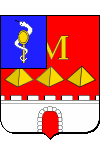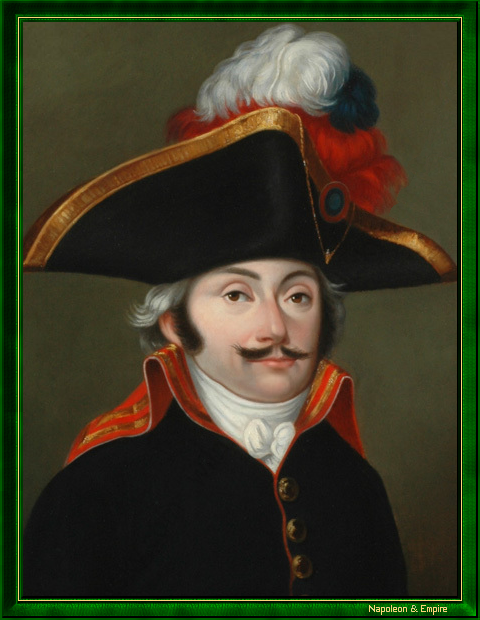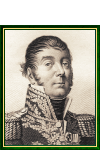Antoine Guillaume Rampon
Count of the Empire
Pronunciation:

Antoine Guillaume Rampon was born in Saint-Fortunat-sur-Eyrieux, in the Vivarais region (future department of Ardèche), on March 16, 1759. He was the son of Jean Antoine Rampon, a retired sergeant, and Suzanne Milhot, a notary's daughter.
Young Antoine Guillaume followed in his father's footsteps, enlisting in the royal army on May 14, 1775. On the eve of the French Revolution, he left the army with the rank of sergeant-major.
In January 1792, Rampon returned to service as a second lieutenant. On August 5, he was promoted to lieutenant in the Armée du Midi. Successive reorganizations of this army finally sent him to the army of the Eastern Pyrenees the following year. Here, he took part in the Roussillon war, which pitted France against Spain from March 7, 1793 to July 22, 1795. The fighting gave him the opportunity to shine. Rampon was appointed captain on September 8, 1793, then provisional adjutant general battalion commander on October 5, provisional brigade commander on October 14, and provisional adjutant general brigade commander on the battlefield of Villelongue dels Monts on November 19 of the same year. His luck changed during the fighting that led to the Spanish capture of Collioure in December: Rampon was wounded and captured. On his return to France after the end of hostilities, he was reinstated to the rank of brigade commander, which the authorities had permanently conferred on him on May 1, 1794.
Once the Roussillon war was over, Rampon was assigned to the Army of Italy, where he took command of the 21st demi-brigade. On April 11, 1796, entrenched in the Monte Legino redoubt with a single battalion of the latter, he achieved the feat of stopping the division of Austrian general Eugène Guillaume de Mercy d'Argenteau [his heroic actions were illustrated by painter René Théodore Berthon in 1812 ]. Rampon was promoted to brigadier general the same day for this feat of arms. His stubborn resistance enabled Napoleon Bonaparte to win the first victory of his career as General-in-Chief at Montenotte the following day, and triumphantly launch the Italian campaign. Rampon then took part in the battles of Millesimo, Dego, Arcole, Rivoli and La Favorite.
After a brief interlude in Switzerland, Rampon accompanied Bonaparte to Egypt in 1798, as did a large part of the Italian army. He fought in the Battle of the Pyramids, then took part in the Syrian Expedition in 1799. In particular, he served during the capture of Gaza and Jaffa , the siege of Acre and the battle of Mount-Tabor. Jean-Baptiste Kléber, who took command of the Egyptian army after Bonaparte's departure, appointed Rampon Major General in January 1800. Rampon lived up to his promotion during the Battle of Heliopolis and that of Canope (March 21, 1801) and the English siege of Alexandria (September 1801). After the French surrender signed by General Jacques François Menou, Rampon returned to France with the remnants of the army. He arrived in August 1801.
He was not forgotten by the First Consul, who had made Rampon a senator in December 1800 and conferred him a saber of honor on June 7, 1802. However, this favor was accompanied by a retirement date of November 10, 1802, which may be considered premature. The young groom (Rampon had married an 18-year-old woman, Elisabeth Riffard de Saint-Martin, the daughter of a former Conventionnel member, on May 8) enjoyed a relatively peaceful life until 1813, punctuated by the honors bestowed upon him. He became Grand Officer of the Legion of Honor on June 14, 1804, was awarded a senatorial seat in Rouen in 1806, adding to his already comfortable income, and was named Count of the Empire in 1808. His military service during this period was limited to various commands within the boundaries of the Empire.
Rampon returned to active service in November 1813, defending the Dutch town of Gorcum [Gorinchem] until February 1814. Taken prisoner again after the surrender of the town (February 21), he returned to Paris on May 31. King Louis XVIII named him Peer de France on June 4 and Chevalier de Saint-Louis on June 27.
During the Hundred Days, Rampon rallied Napoleon. The former senator was elected to the Chamber of Peers on June 2, 1815, then took part in the defense of Paris, between the Seine and Bicêtre, after the battle of Waterloo. This behavior obviously led to his disgrace upon the return of the Bourbons. He was struck off the list of peers on July 24, 1815, but reinstated on March 5, 1819, as part of the first "batch" of appointments obtained from the king by Élie Decazes, which the minister needed to push through his liberal reforms.
Rampon died in Paris on March 2, 1842.
Freemasonry: Initiated in his native province at "La Parfaite Union" in Tournon, probably in 1807, General Rampon was successively affiliated to the lodges "L'Impériale des Francs Chevaliers" (Paris) in 1808, "Saint-Louis des Amis Réunis" (Calais) the same year, "Sainte-Caroline" (Paris) in 1809, "Les Vrais Amis" (Ghent) between 1810 and 1813, "La Parfaite Union" (Douai) in 1812, "Saint-Napoléon" (Paris) in 1812, of which he was venerable, "Saint-Frédérick des Amis Choisis" (Boulogne) also in 1812, and "Le Faisceau" (Toulouse) in 1814. His Masonic involvement culminated under the July Monarchy, between 1833 and 1835, when he became Grand Conservateur of the Grand Orient de France.
General Rampon around 1801 or 1802. Period painting.

Other portraits

"Antoine Guillaume Rampon, Count of the Empire." 19th century engraving.